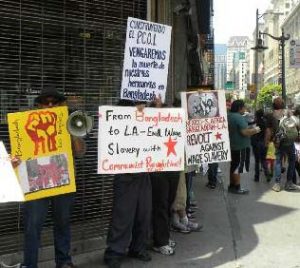“If you cannot absorb the youth in productive activities, they will do something. And that something will not be very pleasant socially…it is a time bomb,” said Zahid Hussain, a World Bank economist in Bangladesh.
Bangladesh is one of the countries where the capitalist class, with the help of the European imperialists, has used repression, nationalism, and exploitation to submerge the working class in profound poverty. The workers constantly protest with mass strikes and rebellions.
The garment industry represents 80% of its exports and is its main source of jobs, especially among young women, who often are the only source of income for their families. But, even with wages as low as $68 a month, this industry has been invaded in the last few years by German, Spanish, and Japanese high tech machines (robots) that replace thousands of workers in the mass production of clothes.
For example, in the Mohammadi Fashion Sweaters factory in Dhaka, the capital of Bangladesh, a few dozen workers control 173 machines that knit sweaters for H&M, Zara and other famous brands. This factory had employed 500 workers before the new machines were brought in.
In Bangladesh, from 2013 to 2016, the production of clothes for export increased by 19.5%, but the number of new workers who enter the industry annually dropped enormously, creating a massive army of unemployed youth who are angry at the capitalist system.
In 2013, the garment building Rana Plaza collapsed, killing over 1,100 women and men workers and creating massive discontent among the workers and the whole population. Since then, the bosses have invested more in using robots to increase production and supposedly reduce confrontation with workers.
“I think that the majority of the owners of sweater factories are happy with the mechanization because that will avoid labor disputes,” said Huq, of the capitalist group Mohammadi.
They are dreaming. They do not know the revolutionary nightmare that awaits them. The millions of women and men garment workers in Bangladesh are in constant struggle against the conditions created by the bosses. A link is being created with them through a group of comrades and readers of Red Flag, who are bringing the alternative of communist revolution through our newspaper and through discussions about communism.
They will be the spearhead for a communist world and against capitalist happiness. They will organize and mobilize the masses for communism, developing militant and massive class struggle, and leading the masses to the seizure of communist power. These comrades will guarantee that Zahid Hussain’s prediction about the youth (above) becomes a reality.
In Los Angeles, USA during the 1980’s there were about 150,000 garment workers. Now there are about 60,000. Mechanization created its effect: local unemployment. At that time, the bosses also sought production in places like Mexico, Central America and Asia, where they pay even less. Many of the women and men garment workers in Los Angeles, like workers in the maquilas in El Salvador, are reading and distributing Red Flag, with the goal of building a communist society based on meeting the needs of all the workers.
Capitalism in any industry seeks to maximize profits, whether in “rich” or “poor” countries. The competition between bosses makes the system more rabid and criminal in its attacks on the working class. This is part of the crisis of overproduction, which leads to wars.
Robots will be our allies in communism. Mechanization will be used to improve the lives of our new free workers, not to send them to the street. The essence will be that no one will live on the sweat of other workers. We will all work collectively for the well being of the workers themselves.
We believe that during the development of the revolution and of the establishment of communism worldwide, the production of clothes to cover and protect humanity will be different. We invite readers to discuss and write about this topic.

Los Angeles, USA, 2013

